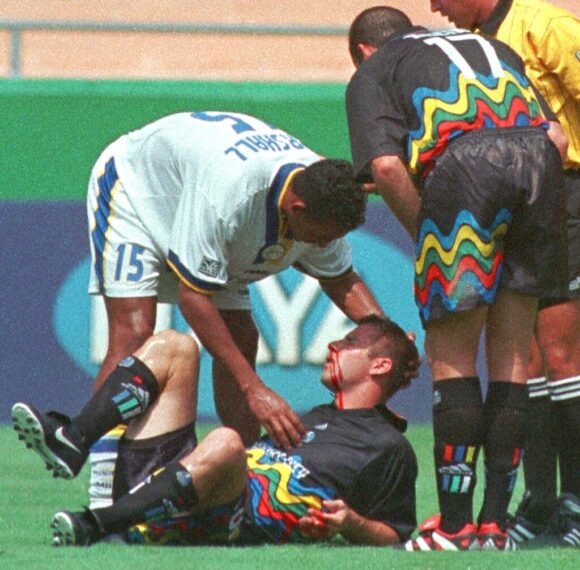BOSTON (AP) — Researchers have diagnosed chronic traumatic encephalopathy in a Major League Soccer player for the first time, saying Tuesday that defender Scott Vermillion suffered from the degenerative brain disease.
The Boston University CTE Center said Vermillion, who died of an accidental drug overdose in December 2020 at the age of 44, had the disease. Although it is not possible to connect any individual case to a cause, CTE has been linked to repeated blows to the head.
CTE has been found in more than 100 former NFL players as well as semi-pro and high school soccer players. Vermillion, who played for the Kansas City Wizards, Colorado Rapids and D.C. United, is the first from MLS.
“Mr. Vermillion has shown us that soccer players are at risk for CTE,” said Dr. Ann McKee, director of the BU CTE Center. “We need to make every effort to identify players who are suffering and provide them compassionate care and appropriate medical support.”
Vermillion began playing soccer at the age of 5 and continued for 22 years, culminating in four MLS seasons. He also played for the United States at the 1993 Under-17 World Championship and made some appearances for the Under-20 team in 1996.
After retiring in 2001 with an ankle injury, his family said, he became depressed and had problems with impulse control and aggression. Eventually, he suffered from memory loss and developed a substance abuse problem.
All have been associated with CTE, which has been linked to concussions or subconcussive blows in athletes, combat veterans and others who sustain repeated head trauma.
“This disease destroys families, and not just football families,” said Vermillion’s father, Dave Vermillion. “We hope this will be a wake-up call to the soccer community to support former players and get them the help they need, so some good can come from this tragedy.”
Thecalled upon the league to break with the sport’s international governing bodies and adopt a rule expanding substitutions to allow for players with concussions.
“We must not sit by and wait for them to do the right thing. MLS should unilaterally adopt a full concussion substitution rule immediately,” the union said in a statement. “Current substitution rules do not give medical professionals sufficient time to properly diagnose potential concussions without putting a team at a substantial competitive disadvantage.”
MLS Chief Medical Officer Margot Putukian said the league has “comprehensive policies to educate players, coaches, officials and medical staffs about the importance of head injury identification, early reporting and treatment.”
“MLS is a leader in the sport, advocating for and piloting the FIFA concussion substitute program, implementing a medical spotter program to identify potential head injuries and removing from play any player with a suspected head injury for assessment and, as necessary, treatment,” Putukian said. “There is always more progress to be made, and MLS is staunchly committed to this important work.”
The Concussion Legacy Foundation has called for rules that would limit tackle football and heading in soccer to children over 14. CLF co-founder Chris Nowinski said dementia has already been linked to repetitive heading by pro soccer players in Britain.
“It is time for the global soccer community to have a real conversation about heading, especially in the youth game,” Nowinski said. “We urgently need to investigate how far this crisis extends into amateur soccer and immediately put in place reforms to prevent CTE in the next generation.”
About the photo: Miami Fusion’s Tyrone Marshall (15) assists Kansas City Wizards’ Scott Vermillion after the two collided while going up for a header in the first half of a soccer match Sunday, Aug. 29, 1999, in Kansas City, Mo. Researchers have diagnosed chronic traumatic encephalopathy in a Major League Soccer player for the first time, saying Tuesday, June 28, 2022, that former Sporting Kansas City defender Scott Vermillion suffered from the degenerative brain disease. (AP Photo/Ed Zurga, File)
Was this article valuable?
Here are more articles you may enjoy.


 Wells Fargo Sued by Ex-Manager Who Said Bank Faked Diversity
Wells Fargo Sued by Ex-Manager Who Said Bank Faked Diversity  Twice Injured Firefighter Loses Second Workers’ Compensation Claim
Twice Injured Firefighter Loses Second Workers’ Compensation Claim  ‘Door Knocker’ Roofers Were Everywhere. NC Farm Bureau Saw an Opportunity
‘Door Knocker’ Roofers Were Everywhere. NC Farm Bureau Saw an Opportunity  Tesla Drivers Are Buying Escape Tools and Cars to Avoid Getting Trapped Inside
Tesla Drivers Are Buying Escape Tools and Cars to Avoid Getting Trapped Inside 